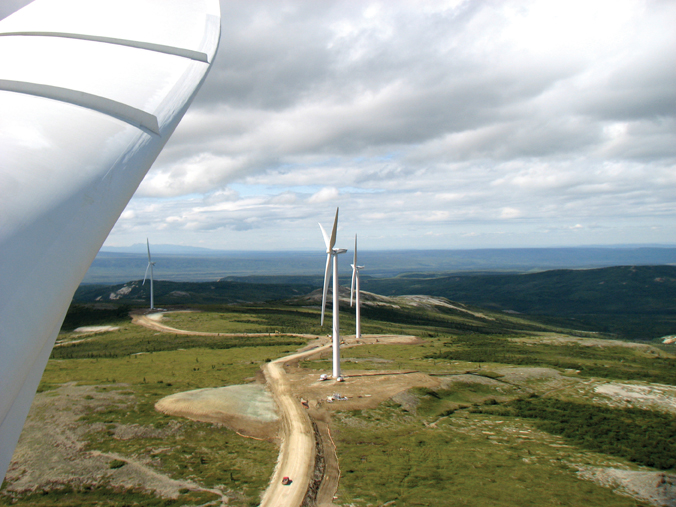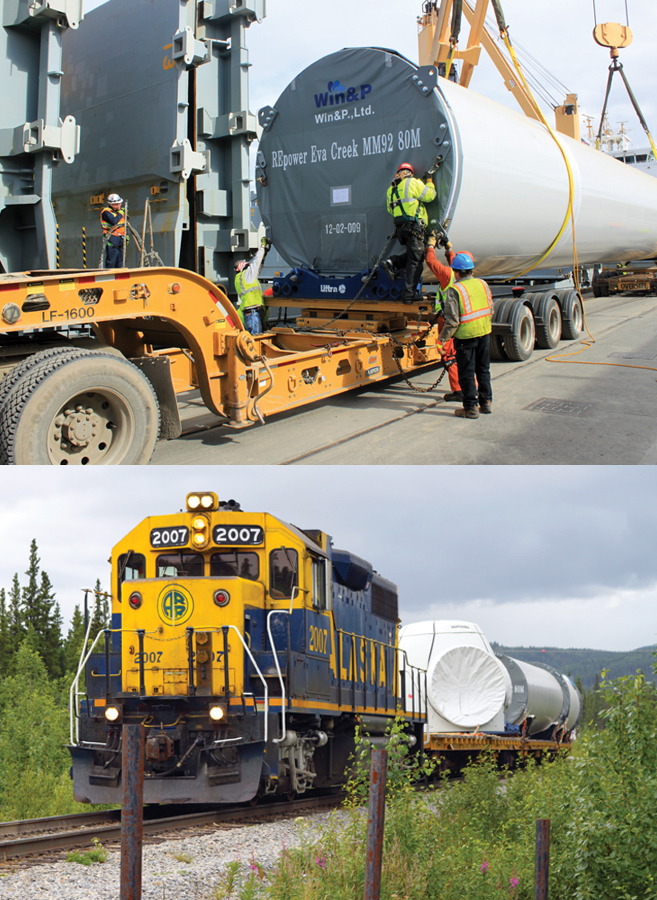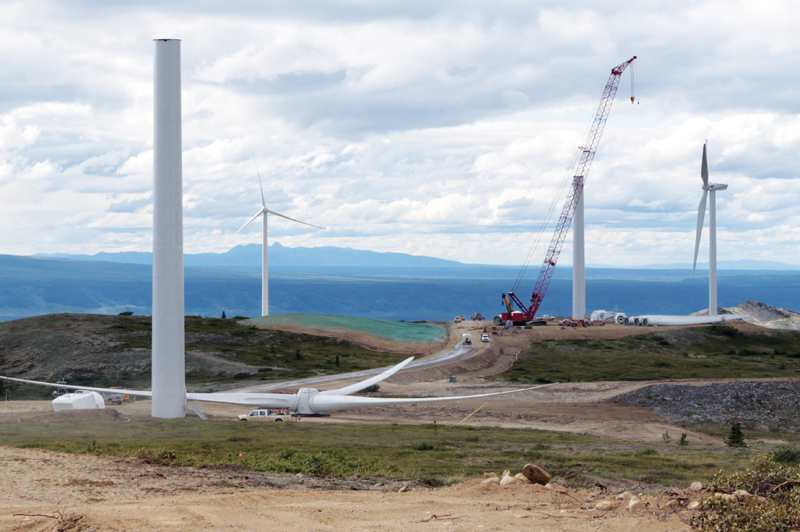Back Issues
Northern wind powerGolden Valley Electric Association—and contractor Michels Corporation—took on one heck of a demanding project with the 25 MW Eva Creek Wind farm in the Interior of Alaska, one of the most northern utility scale wind power projects on the planet. By
Paul MacDonald
It involved building a 12-turbine, 25 MW project. The kicker was that it had to be built at 64 degrees latitude, in Alaska, and the only access in was via a single rail line that led, in turn, to a road leading to the site—with grades up to 10 percent. Suffice it to say, Golden Valley Electric Association's (GVEA) Eva Creek project is unlike any wind project built in the Lower 48 states. In fact, in the planning stages, the utility was uncertain how many construction companies would even be interested in building such a project in Interior Alaska. Wisconsin-based contractor Michels Corporation answered the call. It took a few years to get to that point notes GVEA's project manager, Greg Wyman. In the late 1990s, the state of Alaska was building a new 50 MW experimental coal power plant in Healy, Alaska, adjacent to GVEA's existing coal plant. The intention was that GVEA would operate the plant once it was completed. "As part of the permitting for the new power plant, the board of directors of GVEA worked with the National Park Service, the Sierra Club, and some other environmental groups, and made a commitment to look into and study wind power," says Wyman. Ultimately, the GVEA board made a resolution to have 20 percent of the utility's nameplate capacity coming from renewable energy by 2014. Their peak capacity is about 200 MWs, so that meant achieving 40 MWs of renewable power. GVEA already has a 17 percent share in a hydro power plant—the Bradley Lake Hydroelectric project, about 500 kilometers away, which amounts to about 20 MW. "With that in mind, we started looking at a 20 to 50 MW wind farm and what would be possible with our system," says Wyman. Studies done in 2001 and 2002 focused on the areas that would be within reach of GVEA's service territory, and Eva Creek was one of two prime sites selected for further study. "We put up some met towers, looked at things further, and ended up focusing in on Eva Creek because the site was right underneath a transmission line that we already had in place." Further studies were done, and additional met towers were put in place over the next six years to study the wind resource. "We really could not push the button on building the project, though, because the financing was not there at the time." In the fall of 2009, the Internal Revenue Service gave GVEA the go-ahead to issue clean renewable energy bonds, which provide nonprofit utilities with low cost capital. "This was a big step in moving the Eva Creek project forward," says Wyman. "We were able to look at financing that made sense." He noted that GVEA, a ratepayer-owned utility, was building the wind farm, would be the owner/operator, and was not following an Independent Power Producer or developer model. "Then the Obama administration came out with the stimulus program funding, and one of the benefits is that we were able to get a buy back on the interest rate on the renewable energy bonds. So we were able to sell them with a 1.2% interest rate. "That put us over the top—with all the economics panning out, the project was a go. That's when we started looking at the details and who would be interested in putting what is really a small wind farm at 64 degrees latitude in Alaska." What they've been able to build is one of the most northern utility scale wind power projects on the planet. Wyman noted that there are smaller wind power projects in Alaska and some northern wind farms in Scandinavia, so Eva Creek is certainly in a class of its own in North America.
"Virtually everyone was behind it," says Wyman. "They really liked the idea. We have such high electric rates here that anything that could have a positive effect is attractive. A lot of our power generation is based on oil, so we have high priced power." Power costs are in the area of 22 to 23 cents a kW hour. About 37 percent of the utility's power comes from oil-fired power plants, with the balance being coal plants, hydro, and now wind power. They can occasionally purchase power from another utility in Anchorage—power generated by natural gas, which is less expensive than the oil-generated power. "Our power mix is heavy on oil," says Wyman. "Our mantra at GVEA the last few years is to do what we can to get away from oil, whether it is towards renewables or natural gas." There are, however, no natural gas resources in the area. There is plenty of wind, though. The wind project had the backing of the state government, which was essential since the project is located entirely on state land. "The only private interests are some sub-surface rights that are privately owned. It took a bit of education with some of those folks." With all this support, the project moved ahead. But there were still hurdles. "Everyone thought the wind power project was a good idea, but they did not believe we could get it done in a timely manner." That's where Balance of Plant contractor Michels Corporation came into the picture. Wyman noted that part of the reason Michels was chosen for the job was it has a track record of delivering on demanding construction projects. The company has 4,000 MW of wind experience, but it also has decades of general construction experience. "What they showed us was their logistical capabilities, and we saw early on that what would make or break this project was the logistics." First was the logistics of getting 12 REpower wind turbines to Interior Alaska, which involved cargo ships, trains, and trucks. "In terms of transportation, it was a little bit of everything," says Wyman. Next there was getting the components and construction materials on site. The area leading to the Eva Creek wind power site is separated from the highway system by a major river with only a single transportation link—an Alaska Railroad rail bridge. "Alaska Railroad has a line from the Anchorage area up to Fairbanks, and the bridge happens to cross the river right at the base of the hill leading up to the site," says Wyman. Through the latter part of 2011, and a good part of 2012, that one rail bridge with an adjacent 45-inch walkway, would be the one and only link bringing in thousands of tons of materials and equipment—and people. "Everything—every crane, every truck, every blade, every gallon of oil, every worker—had to come across that rail bridge." The REpower nacelles and hubs came from Germany, travelling by ship across the Atlantic, through the Panama Canal, and up to the port of Anchorage. The blades started out by rail from the LM Wind Power blade plant in Little Rock, Arkansas. While it sounds unlikely, the blades were able to stay on rails right to the site. The loaded rail cars from Arkansas were put on a rail barge in Seattle, which took them to the town of Whittier, Alaska, where they were put on the Alaska Railroad line. The towers came from Korea and were shipped to the Port of Anchorage. "Though it was not planned this way, the towers and the nacelles showed up in Anchorage within a day or so of each other," explained Wyman. "They were off-loaded at the port and stored for three weeks, until we were ready to accept them at the site. Because of the rail and access issue, we only had so much space to store material and components." The nacelles and the towers were trucked into the town nearest the site, Healy, about 250 miles from Anchorage, and transferred to rail cars there.
|











